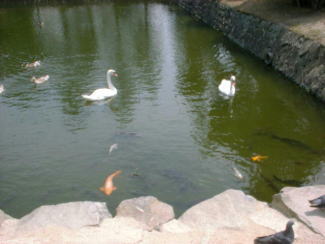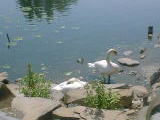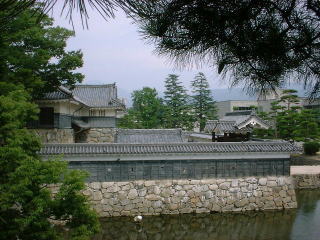
from Matsumoto station to Ekimae street

Fukasi 2 chome, turn left here
|
When you visit Matsumoto Castle, I suggest
you to come by train. Castle towers are not
the only place to see. There are a lot more
to see besides those. Almost every tourists
visiting the Matumoto Castle by cars or tour
buses parked the vehicle at the parking lot
near the red bridge which was built in Showa era for tourist. The bridge itself isn't
bad to see, but it is certainly not the way
to get in the castle area. People who get
in such way should miss a lot of fun seeing
the places beside the towers. If you parked
your car at the parking, at least I suggest
you to walk around the moat to the east and
go through the Drum Gate and Black Gate to
get in. You would probably feel rich getting
a lot more by this way.
OK, then, you come by a train and get off
the train at the Matsumoto station, please
way out the station through the east exit.
Please keep on walking two blocks till the
crossing named Hukashi 2 chome comes by,
in case you come by your own car, there is
a tolled parking right side of the cross.
Please turn left at the corner. This street
where you are is called Honmachi street,
and was one of the main streets in castle
town those days. It was a merchants' town
and there were whole sellers shop along this
street. Now the city is trying to develop
this area energetically. |

Usitunagiishi

a crossing with Nakamachi street
|
Walking along the street for a while, you
will come across a stone at the corner of
the crossing with street which was one of
the branch streets in castle town those day.
The stone with sacred festoons is called
usitunagiishi which means " a stone to tie a bull
to". It was used for tying up oxen for
a rest when they had been carrying salt down
from the north on the old salt road. At
the civil war time, when Takeda force and Uesugi force had some battles in this area, Imagawa force which was based in Sizuoka, had the sea, stopped sending salt to Takeda because Imagawa also against the Takeda, Takeda was ruling this area and people were suffered,
you see man can't live without salt. Uesugi also had sea, even though he was fighting
with Takeda, he couldn't see the people suffered lacking
of salt. He send salt via Itoigawa and Omachi
using oxen's back. The salt got here on January
10th, 1568. A festival started to celebrate
the arrival of the salt. And the festival
is still held every year ever since.
When we walk a little more, we see one
more T crossing. This street crossing to
Honmachi street is Nakamachi street, one
of the main streets in those days. Nakamachi
was a town of merchants and craftsmen. There
are lots of dozo, or earth storehouse, kept in good conditions,
and developing the town as the image of dozo. This street is a good place to shop suvenirs,
and window shopping. |

Titose bridge, viewing Daimyo street
|
Now we are coming up to a big bridge, Titose bridge.The river down below is the Metoba river. After crossing the bridge the road
curved L shaped, there was a outer moat paralleled
to the river and the huge gate, Otemon was there. The height of the gate was about
the third floor of the Bank's building in
front of us.
It is fun to imagine how it was like in those
days.
The street along the river to the right is
Nawate street. There are small shops along the
street, and cars are off limited. You can
walk and have fan without bothering by the
cars. |

Daimyo street
|
After crossing the bridge, we are now in
the castle area if we were in those days.
The street we are now is called Daimyo street, high ranking samurai's street. There
were huge houses for high lanking samurai's
along both side of the street. |

Don't go straight, it's a bad idea!!
|
We can see the towers of the castle from
here, but please take it easy and don't make
any mistakes here. Walking strait to the
castle towers is not right. You have to turn
right here and keep walking along the moat.
Is a kind of long cut to get there, but you
will get a lot of good things. Let's take
the Drum Gate on our way.
Click the picture below to see more details
about the Drum Gate.
 |

It's all depending upon the weather and the
skill of yourself.
|
Did you enjoy the guide of the drum gate?
We are heading to the Black Gate.
Please have fun seeing beautiful fat carpand swans in the moat . If the weather is right, this
is one of the best place to take picture
of the castle towers. The picture with Mt.
Jyonen is the best, I think. |

carp, swans, ducks, pigeons are all at once
in a moment
|
Well, how did you like the scenery? The left picture is a piece once in ten years chance
to take. I was so lucky, but couldn't focus
well.
let's go buy tickets and get in the main
enclosure.

swans napping in the afternoon |

The Black Gate viewing from the west. |
The ticket office is in the court yard of
the Black Gate. Working hour of the office
is usually from 8:30 to 16:30.600yen for
an adult including the entrance fee of the
folklore museum.
The Black Gate was reconstructed in 1960,
and the second gate and the fence were done
in 1988. When the Black Gate was reconstructed,
they didn't have enough money, and lacking
of the resources to build. If you knock on
the pillar of the gate you will get the sound
of hollow, It's only a veneer, it's not solid.
If you notice more to the fence surrounding
the gate, they look like a huge folding screen.
This is also one of the defensive devices
to avoid blind spots from enemy attacking. |